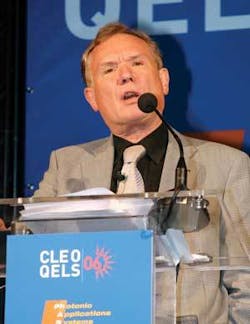CONFERENCE REVIEW: CLEO/QELS conference delivers the right mix

From quantum physics and fiber lasers to homeland security, biomedical optics, and materials processing, the 2006 CLEO/QELS conference (Long Beach, CA; May 22-26) offered a well-balanced mix of the “state of the art” in lasers and optoelectronics and their real-world applications, plus the science behind it all. The 5200 attendees—on par with last year’s attendance, according to show organizers the Optical Society of America (OSA; Washington, D.C.)—were treated to more than 200 technical sessions and 2180 paper submissions, plus a busy exhibit hall filled with 310 companies and organizations showcasing their products and services.
One of the more prevalent themes at the conference was imaging. At the press luncheon—aptly titled “The Future of Imaging”—James Fujimoto, professor of Electrical Engineering and Computer Science at the Massachusetts Institute of Technology (MIT; Cambridge, MA), talked about advances in OCT, noting that ultra-high-resolution OCT has improved the resolution from 10 µm down to 2 to 3 µm, enabling more detailed images of the eye and other tissues, and is moving toward noninvasive detection of cancer and other diseases. In his talk on security and nondestructive evaluation application of high-speed time-domain terahertz imaging, David Zimdars, manager of terahertz R&D at Picometrix (Ann Arbor, MI), emphasized that, while terahertz-imaging techniques are moving out of the laboratory and into commercial use, in terms of real-world applications the technology still has a way to go. And Tim Day of Daylight Solutions (Poway, CA) spoke about the company’s new broadly tunable quantum-cascade lasers, which is being applied to molecular breath analysis, glucose monitoring, and explosives detection.
Ultrafast everywhere
In the exhibit hall, a number of new laser products were announced. Thales Laser (Orsay, France) introduced the ATLAS, an ultrafast petawatt glass-phosphate flashlamp-pumped Ti:sapphire laser system that delivers an energy of 50 J at 527 nm with a pulse duration less than 20 ns and a repetition rate up to 0.1 Hz. Bookham (San Jose, CA) introduced the StableWave and Velocity tunable lasers, which are new models of the New Focus Velocity tunable lasers at 894 and 795 nm for cesium and rubidium transitions and many other new wavelengths for precision optical metrology and interferometry. In addition, Hamamatsu (Bridgewater, NJ) introduced quantum-cascade lasers ready for incorporation into OEM laser systems for environmental gas monitoring and other applications.
Bookham also introduced detector and laser-based accessories including new high-speed avalanche photodiode (APD) receivers for ultra-low-light-level detection applications and Tiny Picomotor Actuators, designed to move up to 3 lb from within a tiny footprint. Low-light measurements are also the focus for Hamamatsu with its 10 x 10 mm active-area APD for high sensitivity and high gain, along with its R9110 photomultiplier tube that provides high performance from the UV to the near-IR.
Coherent (Santa Clara, CA) demonstrated a Silhouette stand-alone pulse controller, based on a spatial light modulator, with an optical platform that provides closed-loop measurement and optimization of both the spectral phase and amplitude of ultrafast pulses. The Silhouette acquires data through a low-profile, fiber-coupled sensor, enabling pulse characteristics to be monitored and controlled at any location within an ultrafast setup—even at the output of an oscillator or amplifier or after beam-delivery optics. Other ultrafast introductions from Coherent included an oscillator delivering more than 3 W of output power and a noncollinear optical parametric amplifier that delivers widely tunable output from the UV through the near-IR, providing a simplified route to pulse widths shorter than 25 fs.
Spectra-Physics (Mountain View, CA) introduced the Spitfire Pro XP and the Spitfire Pro 5W ultrafast amplifiers. Both utilize a single-Pockels-cell regenerative-cavity design. The design “reduces intracavity dispersion and losses to deliver unprecedented specifications for regenerative amplification,” according to product manager Julien Klein. Spitfire Pro XP uses chirped-pulse and regenerative amplification to generate sub-35 fs pulses in a near-TEM00, near-transform-limited output beam with more than 3 mJ at 1 kHz. The Spitfire Pro 5W features a hybrid architecture that combines the benefits of a regenerative cavity and of a multipass amplification to provide a near-TEM00, near-transform-limited output beam of sub-40 fs, sub-120 fs, or picosecond pulses with more than 5 mJ at 1 kHz.
Spectra-Physics also announced a continuous-wave tunable single-frequency ring laser with an external reference cavity to lock the laser wavelength and spectral bandwidth within 500 kHz targeted for scientific-research applications such as high-resolution spectroscopy, frequency time standards and Bose-Einstein condensates. The overall tuning range extends from 550 to 1000 nm.
Among ultrafast-fiber-laser introductions, IMRA America (Ann Arbor, MI) launched a fiber chirped-pulse-amplification µJewel D-1000, offering up to 10 µJ level pulse energy at near-IR wavelengths, and a capability for users to select repetition rates between 100 kHz and 5 MHz, as well as to choose between high-energy operation with 10 µJ pulses at 100 kHz or 1 µJ at 1 MHz. The options allow for materials processing of harder materials or at faster rates, depending upon the application requirements.
About the Author
Kathy Kincade
Contributing Editor
Kathy Kincade is the founding editor of BioOptics World and a veteran reporter on optical technologies for biomedicine. She also served as the editor-in-chief of DrBicuspid.com, a web portal for dental professionals.

Gail Overton
Senior Editor (2004-2020)
Gail has more than 30 years of engineering, marketing, product management, and editorial experience in the photonics and optical communications industry. Before joining the staff at Laser Focus World in 2004, she held many product management and product marketing roles in the fiber-optics industry, most notably at Hughes (El Segundo, CA), GTE Labs (Waltham, MA), Corning (Corning, NY), Photon Kinetics (Beaverton, OR), and Newport Corporation (Irvine, CA). During her marketing career, Gail published articles in WDM Solutions and Sensors magazine and traveled internationally to conduct product and sales training. Gail received her BS degree in physics, with an emphasis in optics, from San Diego State University in San Diego, CA in May 1986.
Hassaun A. Jones-Bey
Senior Editor and Freelance Writer
Hassaun A. Jones-Bey was a senior editor and then freelance writer for Laser Focus World.